The Drakensberg Grand Traverse follows a 120-mile, trail-less route along the escarpment that forms the South Africa/Lesotho border, from Sentinel Peak to Bushman’s Nek, including Southern Africa’s “pretty little mountain” and highest peak, Thabana Ntlenyana.
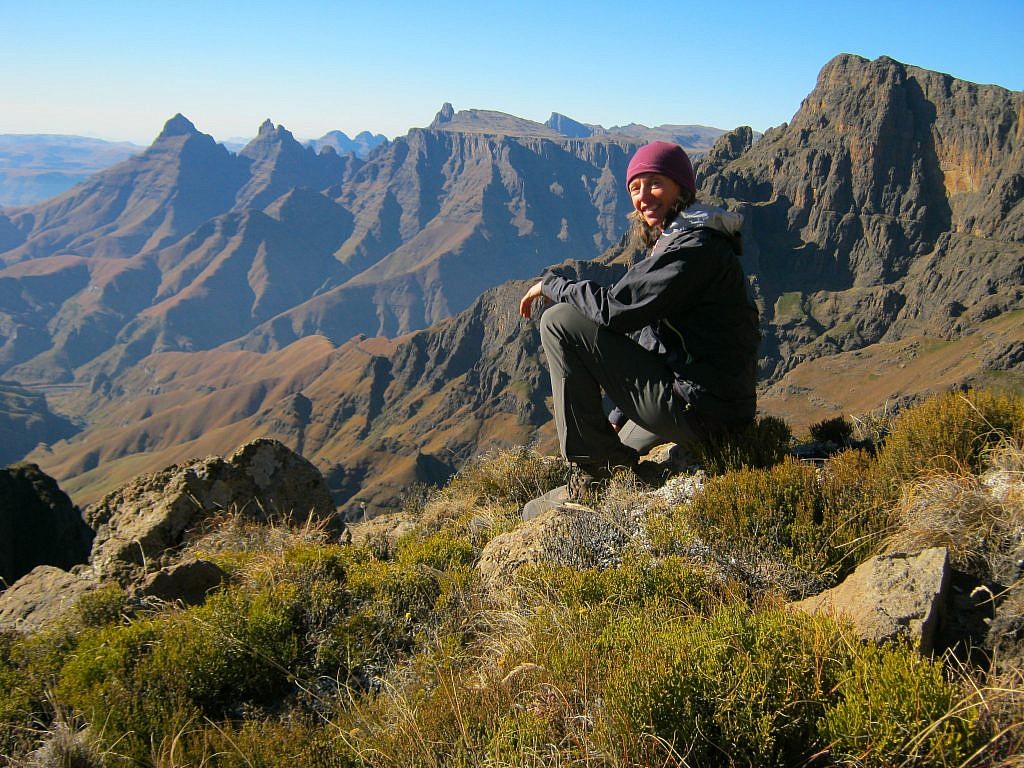
“Fortune favors the audacious.”
Erasmus
You could call us audacious. But you’d also be right calling us downright foolhardy.
My hiking friend from England, Ted, and I decided to walk the traverse of the Drakensberg escarpment in South Africa and Lesotho in winter, all alone and with essentially no trail.
Ted had been going to South Africa on business for years. An ultra marathoner, he won two silvers in the Comrades race and loved training on the numerous trails just below the Berg’s magical jumble of cliffs, hitting the top, but always racing back down to stay snugly in a bed rather than camping above.
He first mentioned to me that he’d like to backpack on top some day when we met on the JMT and my interest was piqued. The moment I got home, I set to work figuring out how we might make this hike work.
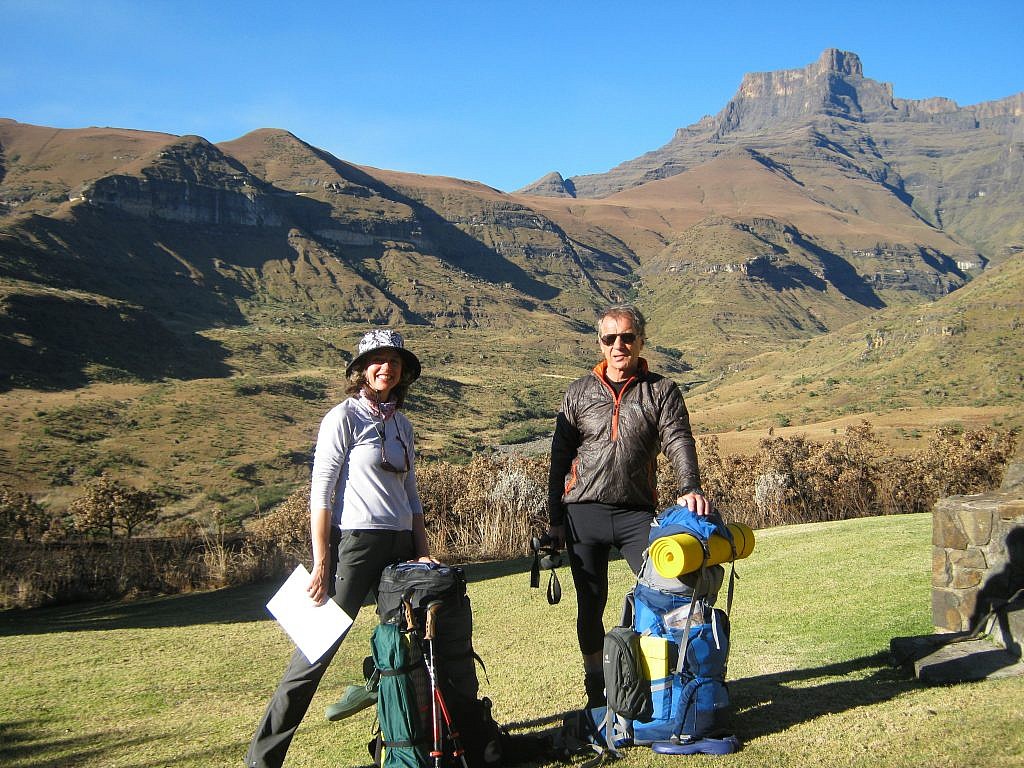
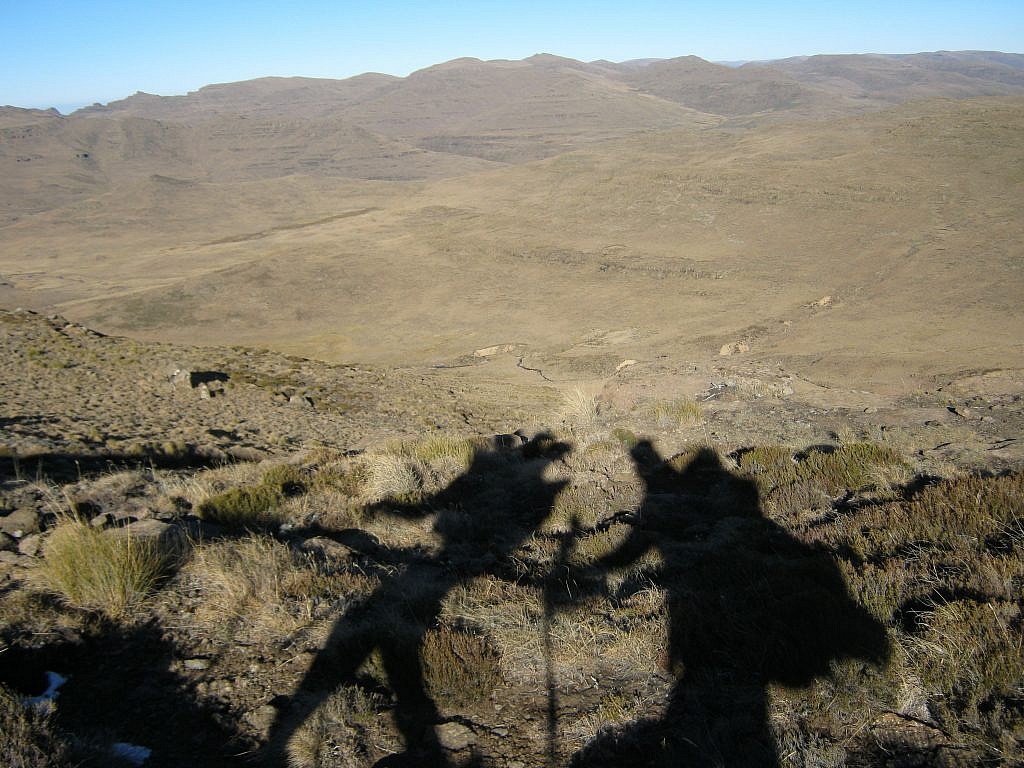
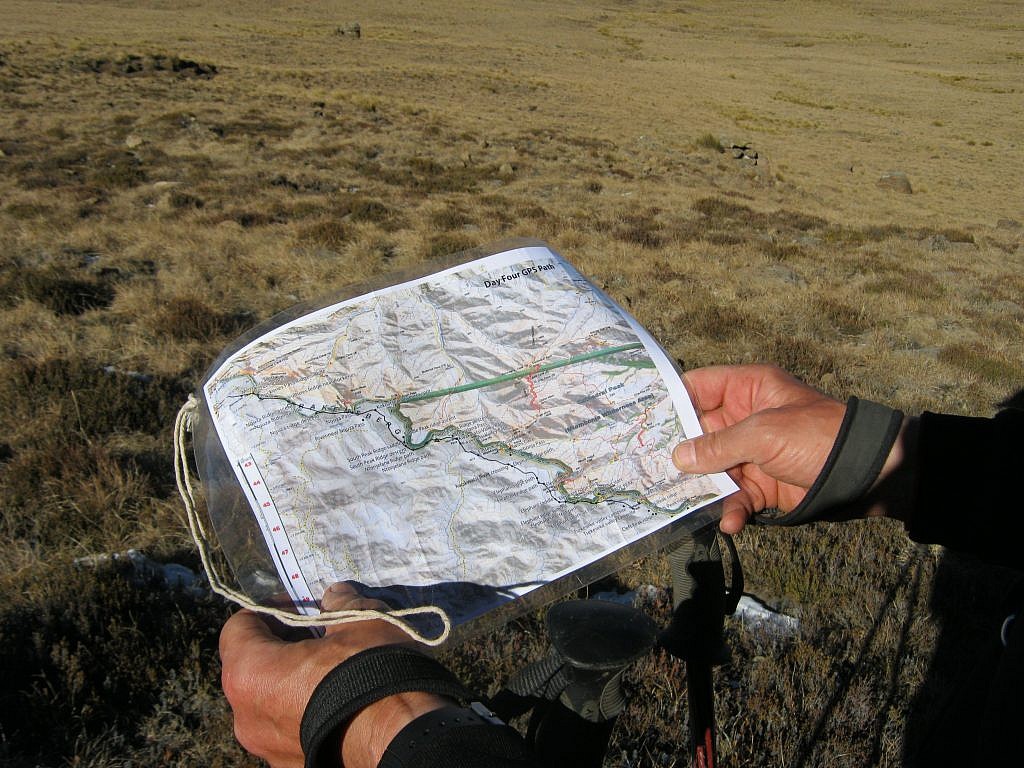
The Mountains of Dragons is the great escarpment that encloses Africa’s central southern plain. It’s the natural border between Lesotho and the state of KwaZulu-Natal. A hiker walking on the top will cross freely between two countries, seeing shepherds and animals, both wild and domestic, and about 300 species of birds.
Eland and reedbuck roam the lower portions of the Berg, while the Chacma baboons guard the few gullies leading steeply to the top.
But in 2013, there was no official trail over the escarpment – at least not in totality. The first thing to figure out was how to find our way across. We decided to go in winter, but early and before the snows come.
Summers produce ferocious electrical storms and the shoulder seasons are rainy and unpredictable. Early June seemed the ideal time with sunny, dry days, even if very short and with temperatures dipping below freezing at night.
It was wise to go with a friend to help carry our heavier tent and warm bags, plus loads of calories. We found a GPS track online from a group that hiked one very rainy April. My husband and Ted worked together to place the points on his GPS and directly on a physical map, which Ted laminated and added string as a handhold for our wrists, in case the winds kicked up.
Now that I have been in England and experienced real rain and wind, I understand why Ted took this precaution!
I was very lucky to have this friend with friends in South Africa. We met Peter and Gail in Ladysmith and all piled into their tiny Toyota for a journey to the start. But not before purchasing a bucket at the local hardware store for our resupply to be picked up on a weekly run from the Giant’s Castle Wildlife Refuge and held for our eventual arrival at the Champagne Castle Hotel in Monk’s Cowl.
That marked about the halfway mark, so we labeled the bucket, crossed our fingers, and set off.
The views were already stunning, striking cliffs coming into view thousands of feet above the grassy plains, dotted with traditional thatched-roofed round houses and locals in bright colors carrying goods on their heads. That first night was glorious in a private house in the Royal Natal National Park’s Tendele Hutted Camp which butted up against an amphitheater of rock crowned by Sentinel Peak.
Ted’s birthday was days away, so Gail ensured we had cake and a special local wine called Pinotage, a cross of grapes that tastes more like Shiraz than Pinot Noir. Rich, delicious and just right before our adventure.
A beautiful morning dawned and we simply walked from the lawn to a trail and up the mountain towards the famous chain ladders. Smoke filled the dry air as a team was lighting controlled burns to prevent a cataclysm. We walked across warmed charred ground, which quickly melted the rubber tips on Ted’s walking sticks.
No matter, we continued, the day quickly gave way to a waning sun in the early afternoon and Ted suggested we stop at Witsieshoek Mountain Lodge. I was suspect of luxuriating so soon, wanting to get the hike started, but it took little convincing as there is practically no twilight in this part of the world, and long shadows led quickly to total darkness.
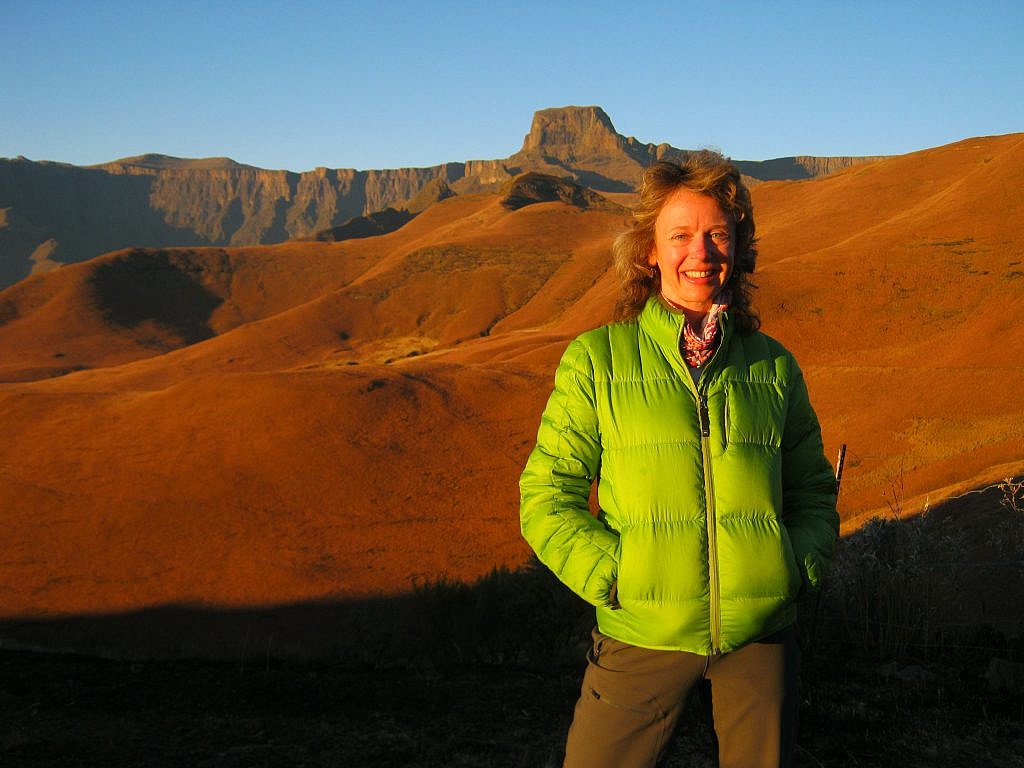
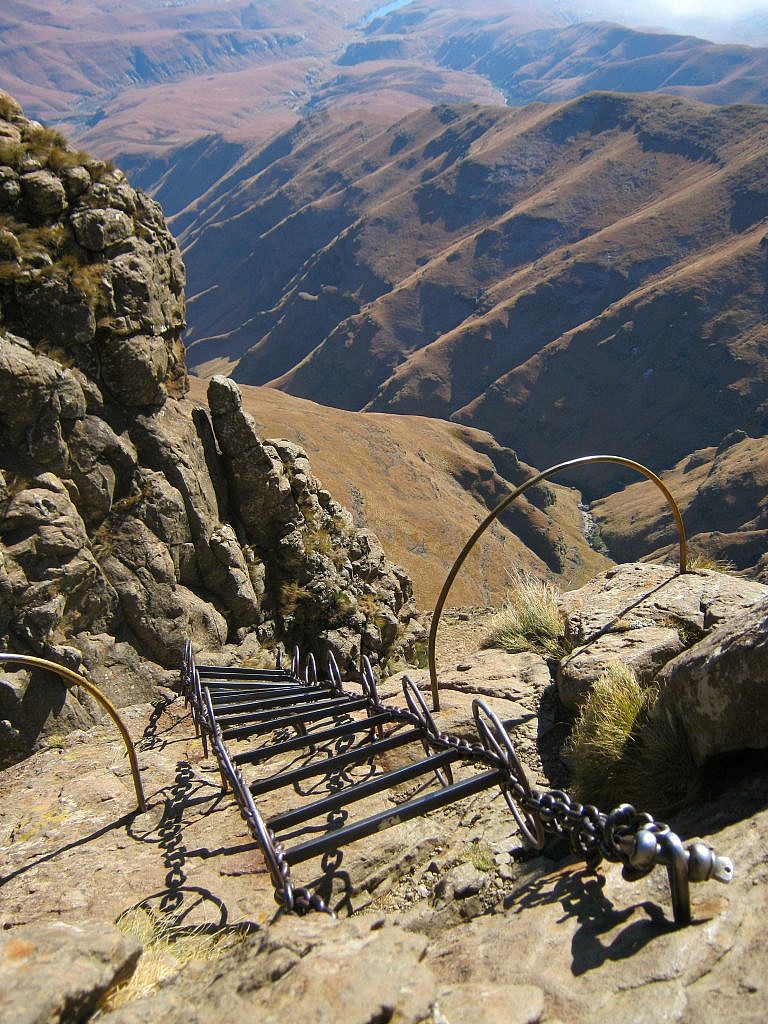
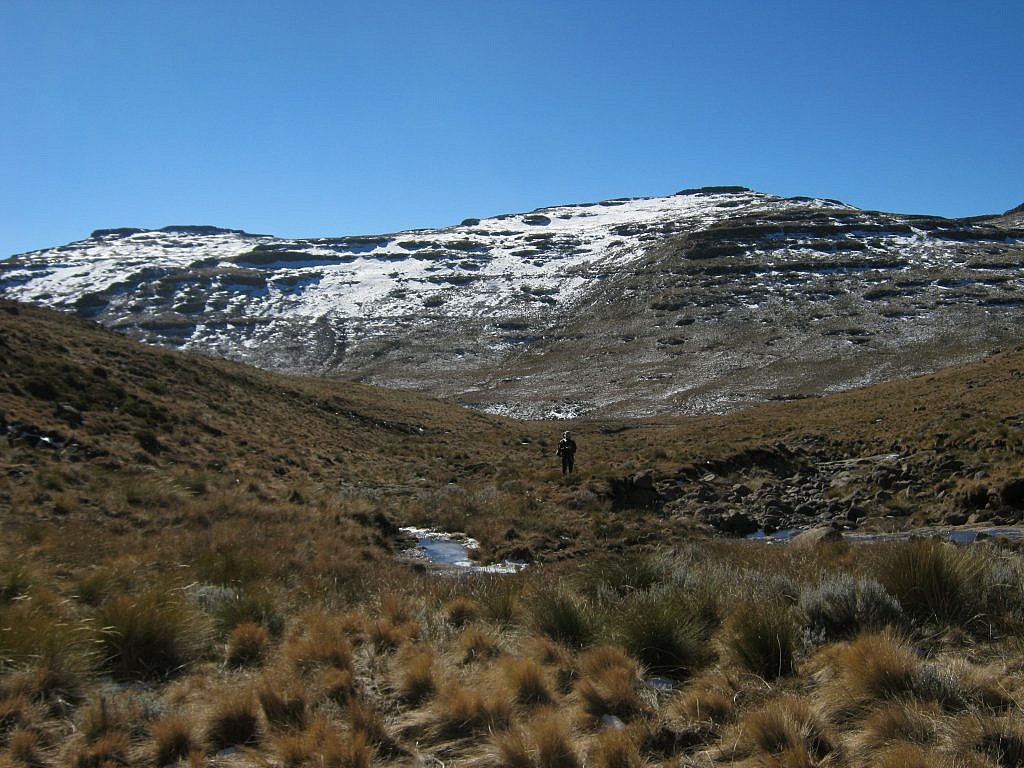
We had a nice meal and a few beers with a spectacular view and warnings about how cold it gets on the escarpment as well as admonishments that we really ought to hire a guide. Nervousness and trepidation stirred up that night, not helped by the enormous and oddly shaped room that was utterly freezing.
The new morning blew any concerns away and we just happened to pop out onto the road leading to the chain ladders while a few day hikers were preparing to get a ride in the “bakkie” of a truck.
This was the first of our miraculously timed hitchhiking. With plenty of room, they loaded us in and took us towards the border, where we registered, showed our passports and paid a tidy sum to enter the unknown.
We lost the guys quickly and came to the end of the trail right on the side of a cliff rising above maybe 100 feet. To your right as you faced this obstacle was the trail going back down, and to your left a wrinkled carpet of grassy hills far below. The ladders are in two sections with about 50 rungs each and a large circular grabbing handles. It’s not a difficult climb, but you don’t want to let go – or look down.
Once above, it was like another world, a treeless moonscape of browning wild grasses, crispy snow, and baboons awaiting a distracted hiker and a rucksack meal. It took a moment to adjust to our new world, but we soon pointed ourselves towards the first campsite used by our generous GPS trail-sharers.
The escarpment is ideal for backpacking because it’s filled with water sources in stark contrast to its bleak nature. It only took us a few hours to find the ideal spot for the tent next to a partly frozen set of streams meeting at a rocky outcrop, perfect for sitting while pumping water and cooking.
That night was when I came face to face with the magic of this place. Our trip took place entirely within the UNESCO world heritage site of uKhahlamba-Drakensberg Park. It is not near any city or town and there are no flight paths over this place. We lucked out fully with the weather, which was crystal clear, not even one cloud in the sky.
Aside from the day hikers, we were the only people out there for miles around. It was absolutely silent, except for the sound of the wind whistling through the grass.
It was cold, but we hung our heads out of the tent to look at the stars, an astonishing array with two strands of the Milky Way spilling across a velvety black sky. It hadn’t occurred to me when I planned our dates, but that first night was a new moon. We would have dark skies for days before she finally swelled to full later in the trip. I will never forget that stunning night as long as I live.
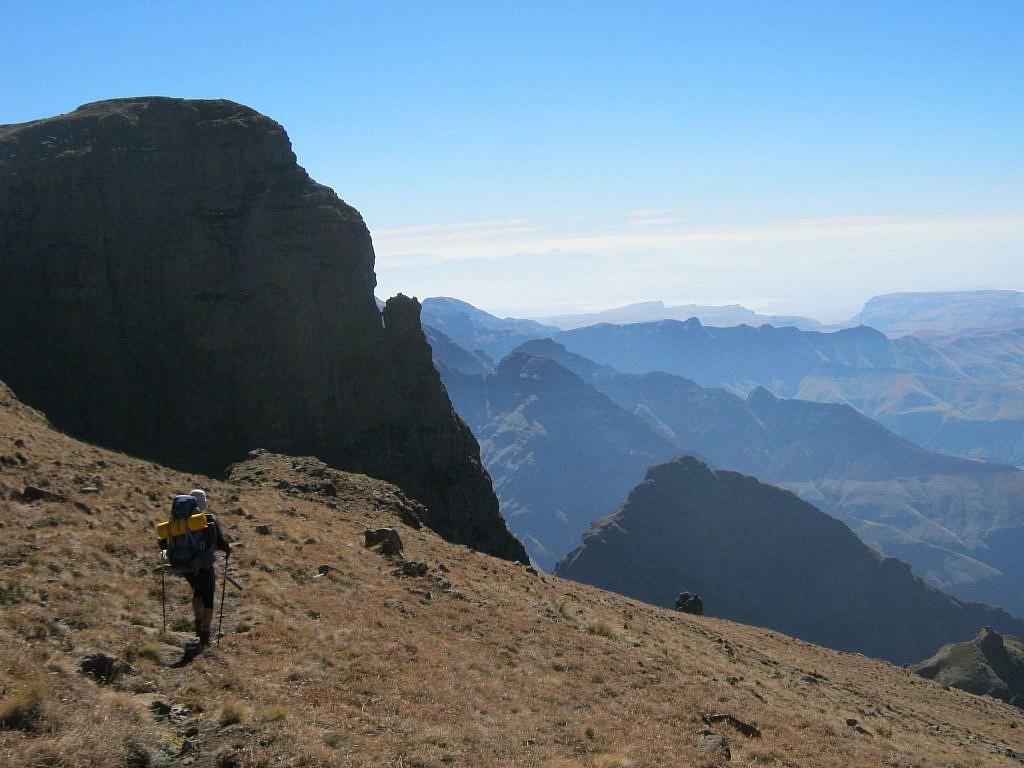
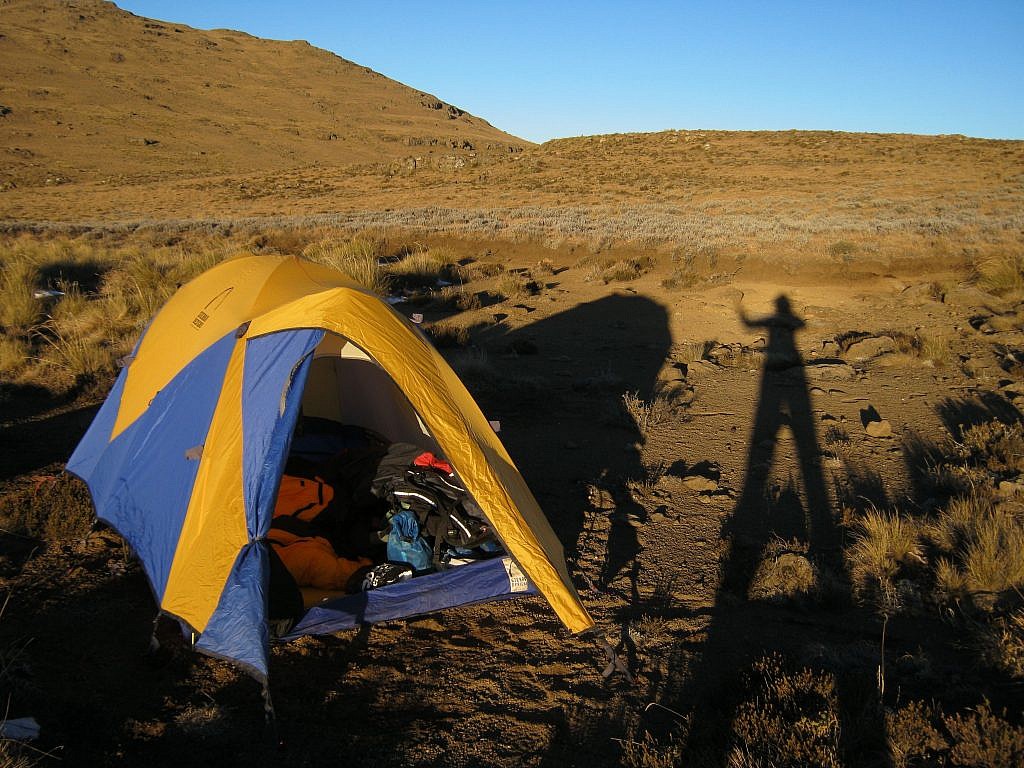
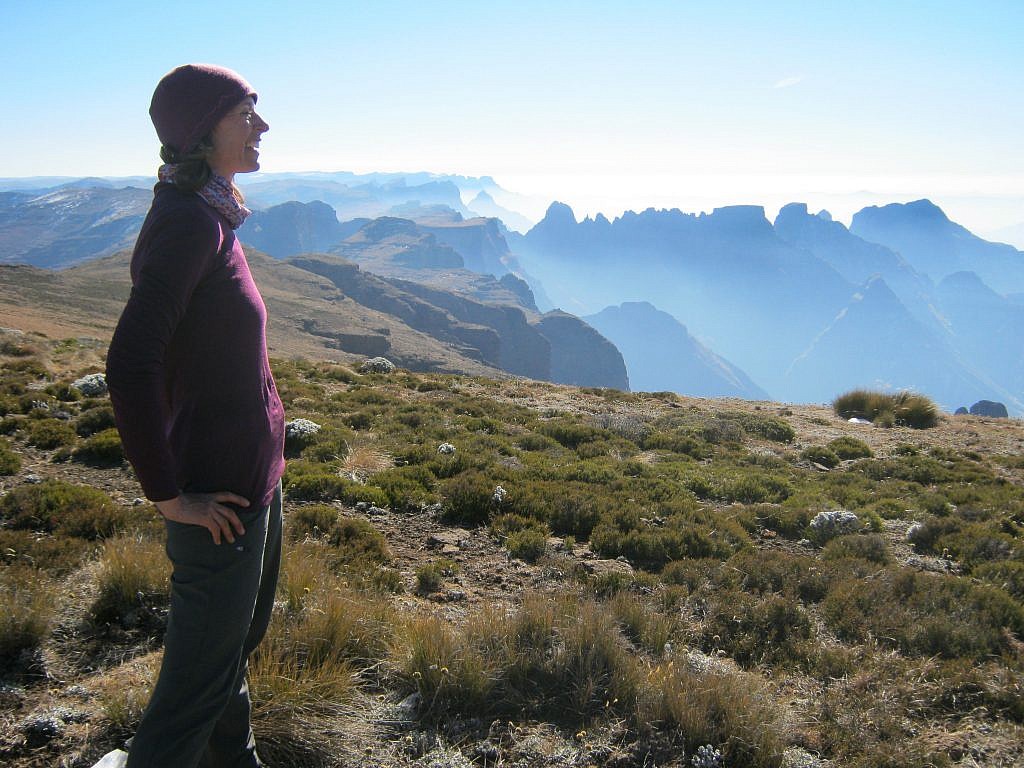
The days that followed put to rest any notion that the escarpment was flat-topped as we climbed up snow covered ridges and then down steep humpy inclines, careful not to twist an ankle. The only moments we could get close to the edge were when a pass would open up leading down into what appeared to be a city of oddly shaped spires.
Ifidi Pass was one such place followed quickly by the equally breath-taking Icidi Pass and Crushsite. In these areas, Bushmen or the San painted exquisite paintings inside caves, living here in a last stand against the encroaching foreigners. Our campsite that night was near water just on the open expanse of the escarpment; wild and lonely, but with a feeling of comfort from the light show in the heavens.
The following morning broke clear and sunny, and I was charmed by my long shadow cast to the north with the sun leaning opposite of home as it made its arc through the sky. The days were brisk, but long sleeves and long pants sufficed – as did glasses, hat and wind stopping gloves.
Far more austere than the Sierras, it was coming upon dried flowers that caught my fancy, dimmed, but still colorful against the monochromatic landscape.
As we approached a hanging valley, we came upon a major pathway. It made walking far easier, but it led to confusion as the highway could only be followed for half a day and no more or it would take us deep into the villages of Lesotho and away from the edge
It would take us four days to work our way towards the enchanted spires of Cathedral Peak in the Mlambonja Wilderness. Snow chased us, but only on the ground as the sky remained crystal clear and free of clouds.
Ice formed on single blades of grass and needed to be chipped from the streams, but our days were all smiles, even if the walking was rough underfoot and the GPS was often checked.
By mid-day most days, a haze would build over the valley below from fires, obscuring the view. But by morning, it was still and clear, a gift from the mountains for our small two-and-a-half week window. And windows describe the edge of eroded, crumbling rock zig-zagging towards safe views to look out upon the magnificence. Ancient volcanoes left this mass of dark brown lava that compressed to rock millions of years ago.
With no tectonic activity in the intervening millions of year, the continent stayed relatively quiescent – at least geologically speaking – the peaks only revealed as the continental plates pushed togetherr. We stood 3,000 feet above the undulating grassland below as we slowly meandered from window to window across the rough, rolling landscape.
By day six, the vastness, loneliness – and the fear placed in us that we might find ourselves besieged by native Lesothans – began to eat at Ted. He wanted to go down. And here we were having spectacular weather, we were moving well and we had at least a day’s food left to get us to our resupply at Giant’s Castle.
But he was adamant.
Hadn’t we told Gail and Peter that we’d pick up the bucket on day six? And besides, we don’t have enough food to get there as it will likely take us two more days.
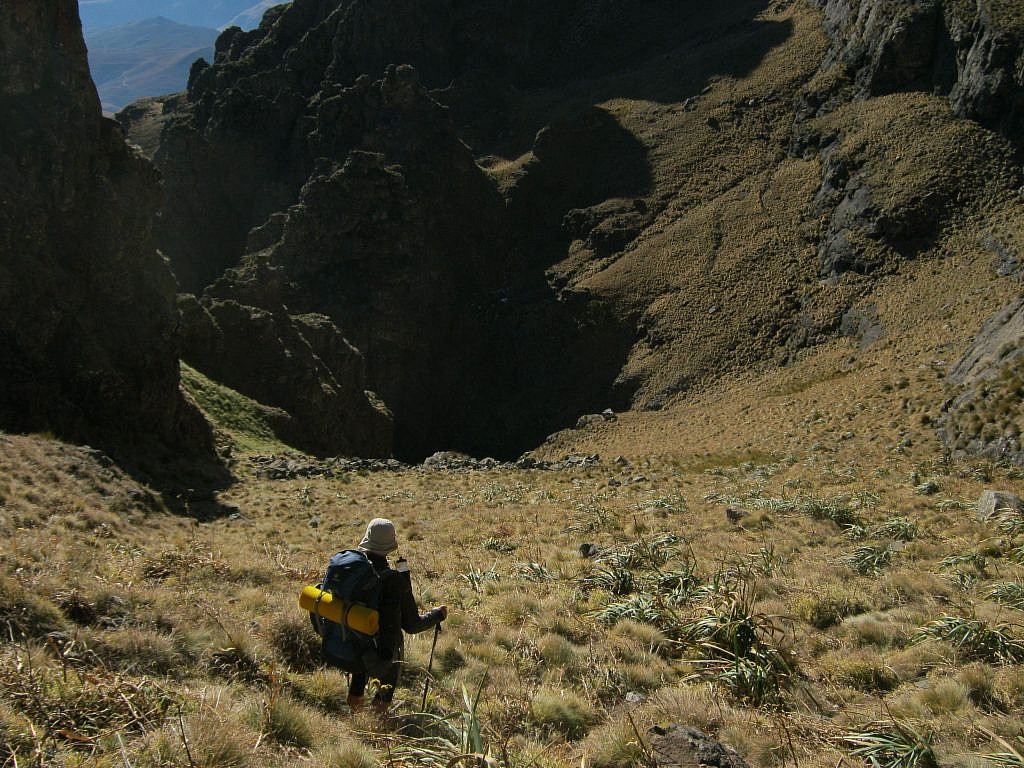
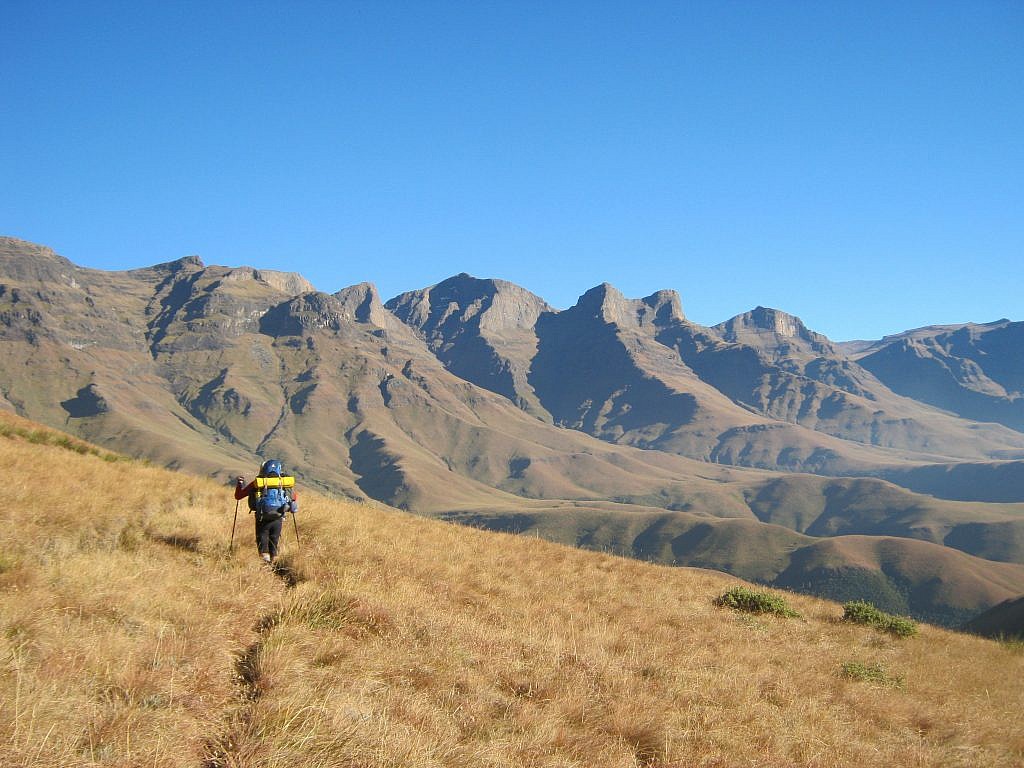
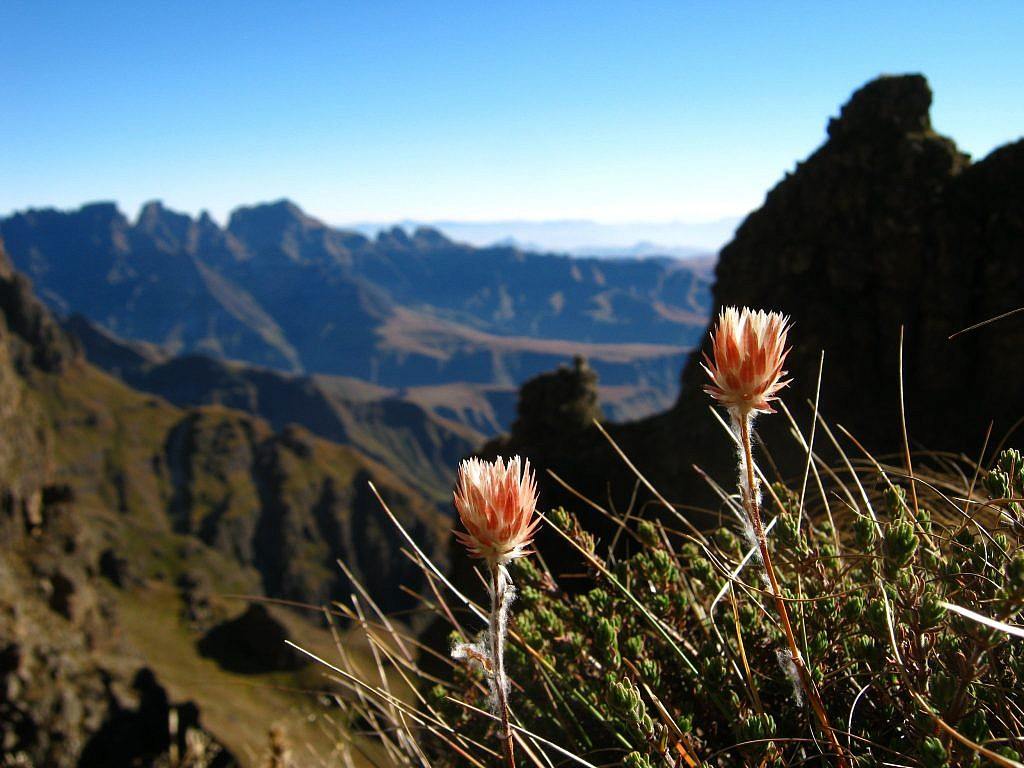
In that stunning scenery, dry, soft and all ours, we fought out about, but I finally gave in. It made no sense to force Ted to keep walking if he felt worried for every step we took. So at the first opportunity, we took a left and thrashed down a gully, pressing down into the lower reaches of the wilderness.
It was obvious from the start that we’d made an error. Baboons sat as sentinels to our retreat, so we were likely on a reasonably safe path, but rather than the more straightforward Tsekeseke Pass, which would have required backtracking to find, we downclimbed at Organ Pass, directly below Castle Buttress.
While the maps do not have a trail marked for the ridge or traverse, every pass is marked; yellow for difficult, red for technical. And there we were descending a red trail.
Fortunately, we never hit an impasse, even if we discovered traveling on our bottoms the safest mode. Exhilaration gave way to decisions when more clearly marked trails appeared. Ted said he recognized the valley and we agreed to continue south along a gulley of burnt sienna hills, a rushing stream below. Camping that night was noticeably warmer.
Ted was keen to fully immerse himself under the ice every night on top though I shied from the bitter cold. But here the gentle fern-fringed pool under a cantilevered rock echoing myriad birdsong welcomed my dusty body. It turned out to be a welcome contrast to the uniform dun of the ridge as even muted tones below were more varied and filled with life.
The next morning we joyfully continued on the trail along the river down and down until it began to turn back north and Ted realized he actually had not recognized this valley after all. We were lost.
Or were we? Lost implies losing the trail entirely, pushing through weeds or forest without any sense of direction. This trail led somewhere, just in the opposite direction of our resupply. Ted lost his cool and strongly urged we retreat to the top where we knew exactly where we were.
I screamed back calling him crazy as the slope was nearly vertical and it would take us more than a day to achieve the top. “You wanted to come down because we were running low on food!” To which he retorted, “But this is poor mountain craft going on without knowing where we’ll end up!”
We finally calmed down and sat down the rushing stream, agreeing that this well-worn path likely led to a village and we could reconnoiter there. And that’s when a trio of Zulu on horseback rode by. They didn’t speak English – much, anyway – but pointed down the trail and said, “Cathedral.” Aha! We were going backwards, and yet, all of a sudden, that didn’t seem like such a bad idea.
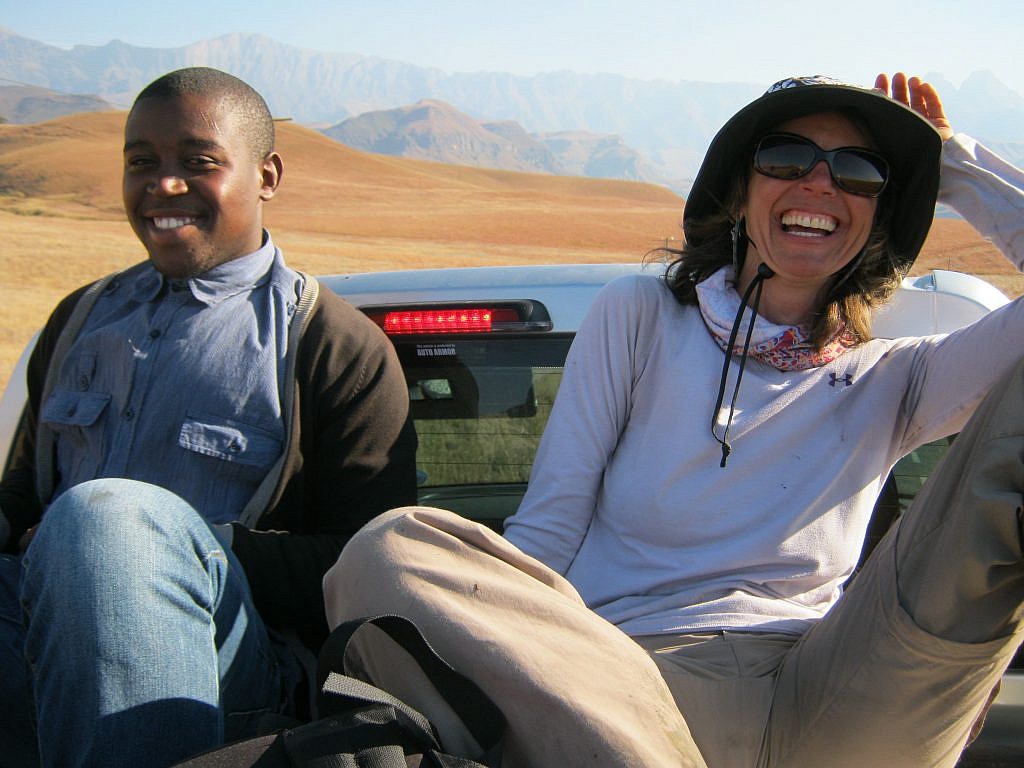
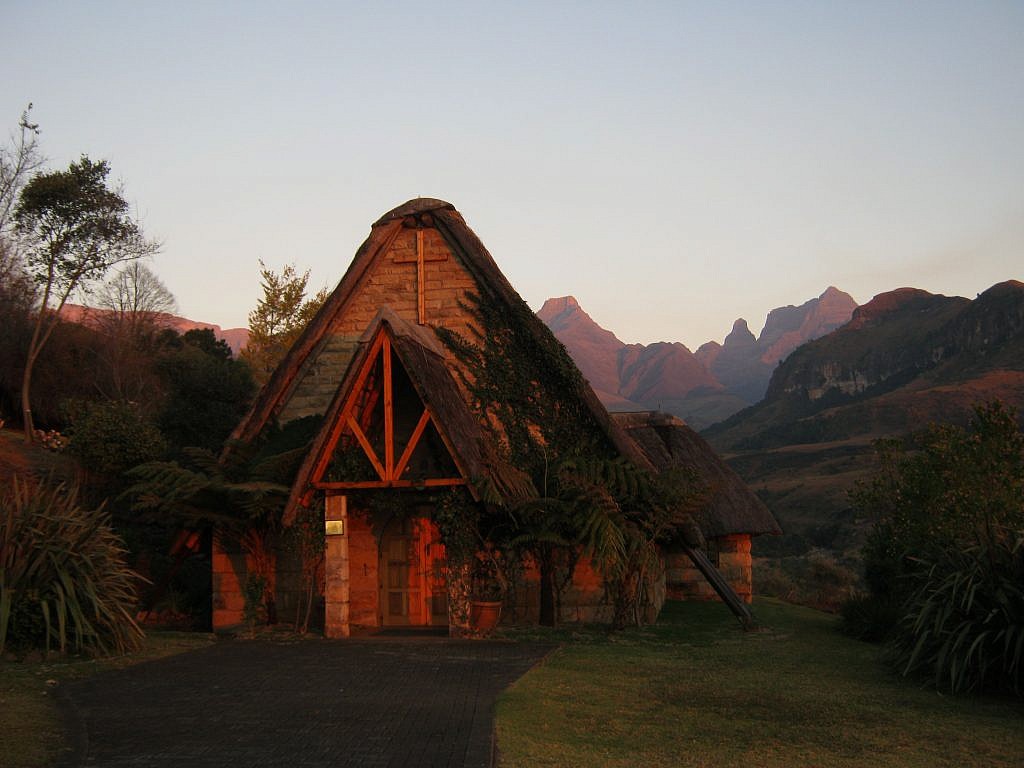
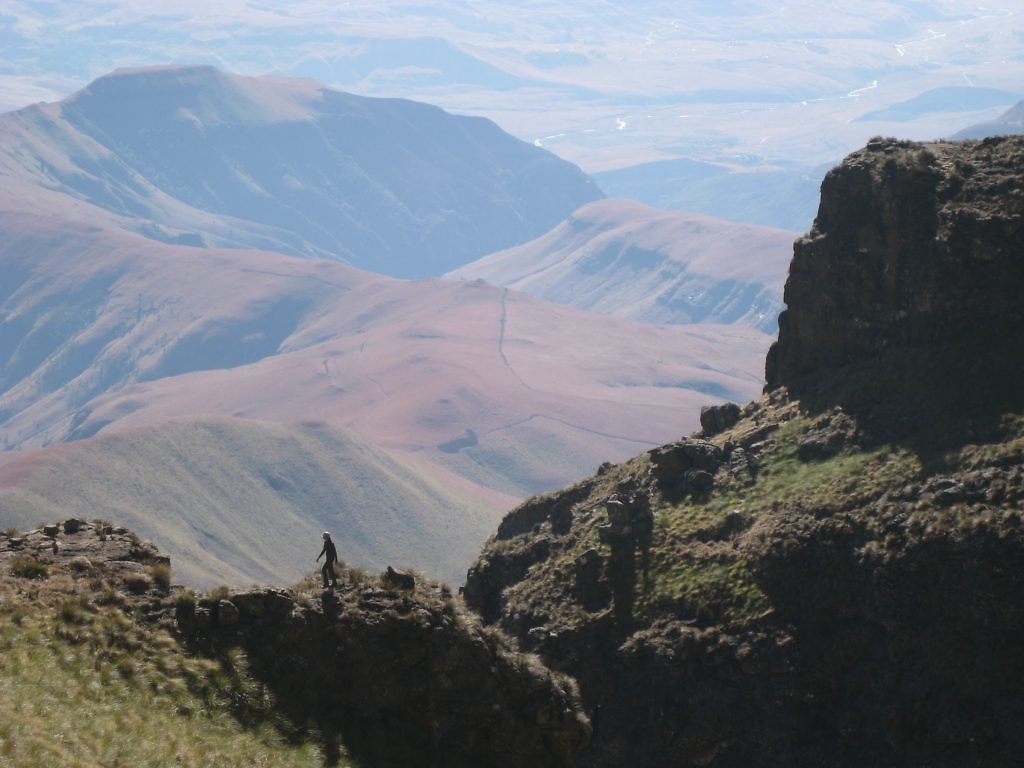
Cathedral refers to the stunning collection of mountain peaks we had just walked above but also to an historic hotel nestled at the base of this magnificent view. Ted had been many times and said it truly is a magnificent place worth visiting – even if off the itinerary.
So we pushed on, out upon a plain with scattered acacia and finally to a tarmac where the second miracle of the day occurred as just then a truck pulled up. I ran ahead yelling, “Stop!” It was a local farmer delivering vegetables to the hotel’s kitchen. He was picking up a couple of boys walking the long hot road to go to work.
We all hopped in the bakkie and sped along the road for several miles to a scene far removed from our last week of solitude and silence: a hopping resort where even in our trail-worn clothing and with weary, dirty faces, we were seated with a view of the splendid range and served right away a couple of cold Amstels.
The next miracle was on that very night, the hotel was hosting a wine tasting coupled with a grand buffet of every imaginable food a backpacker might crave while on trail. We topped it all off by visiting the thatch-roofed chapel, the peaks a backdrop to its alter. Bliss!
But I wasted no time, much to Ted’s chagrin, and found us a taxi to take us to our resupply at Giant’s Castle the very next day. This was no easy drive below the escarpment; rather the road goes far out of the park, meets the highway going south and has to work back into the park. Half our morning was used up in the redirect, but a night spent at this historic place made it all worth it.
I must admit I always feel surprise and wonder that my resupply is simply waiting for me when I ask for it. A beautiful dark woman with flashing eyes and a bewitching smile led me to her desk where she had stashed our food. Gail had called her to check in and she assured us she would allay any of her concerns of the intrepid walkers with a quick phone call.
We took a deep breath after an old man listening in warned us of the dangers on the top, and instead took the advice of a friendly Xhosa guide who assured us it would be a hard pull straight up the gully ahead, but it was doable.
The walk back out on the grassland brought us eland and klipspringer and an orange glow on the sheer rock ahead of next day’s climb. We camped near a spring right in the grass watching as flames chewed up the grass far below but slowly burnt itself out.
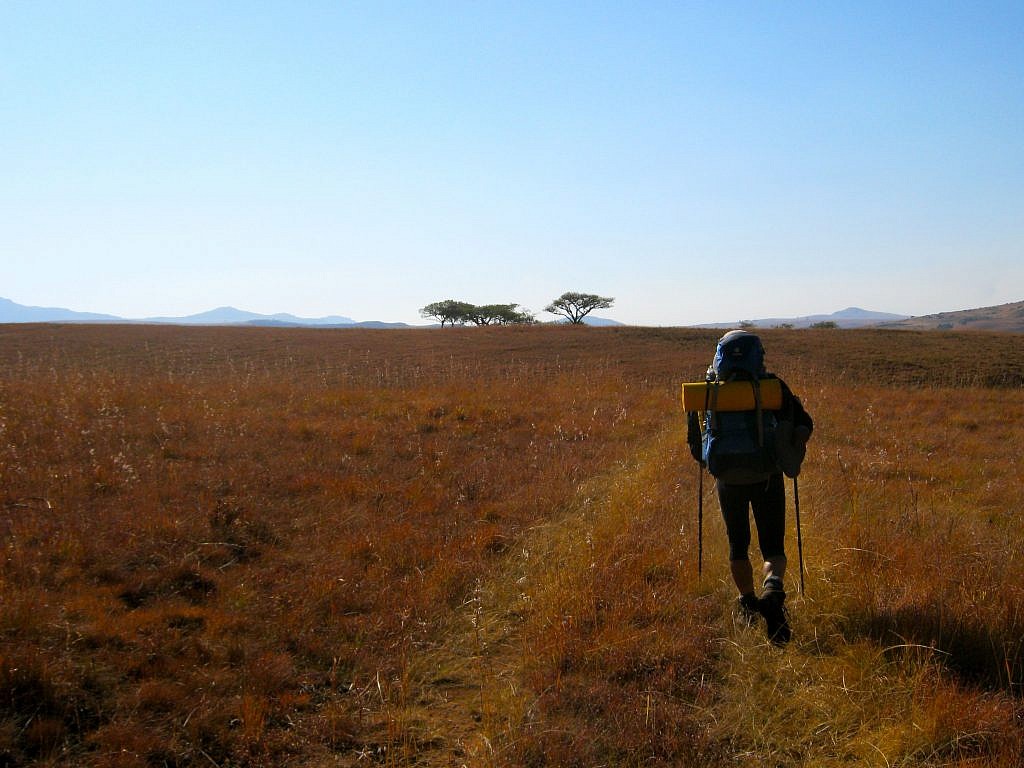
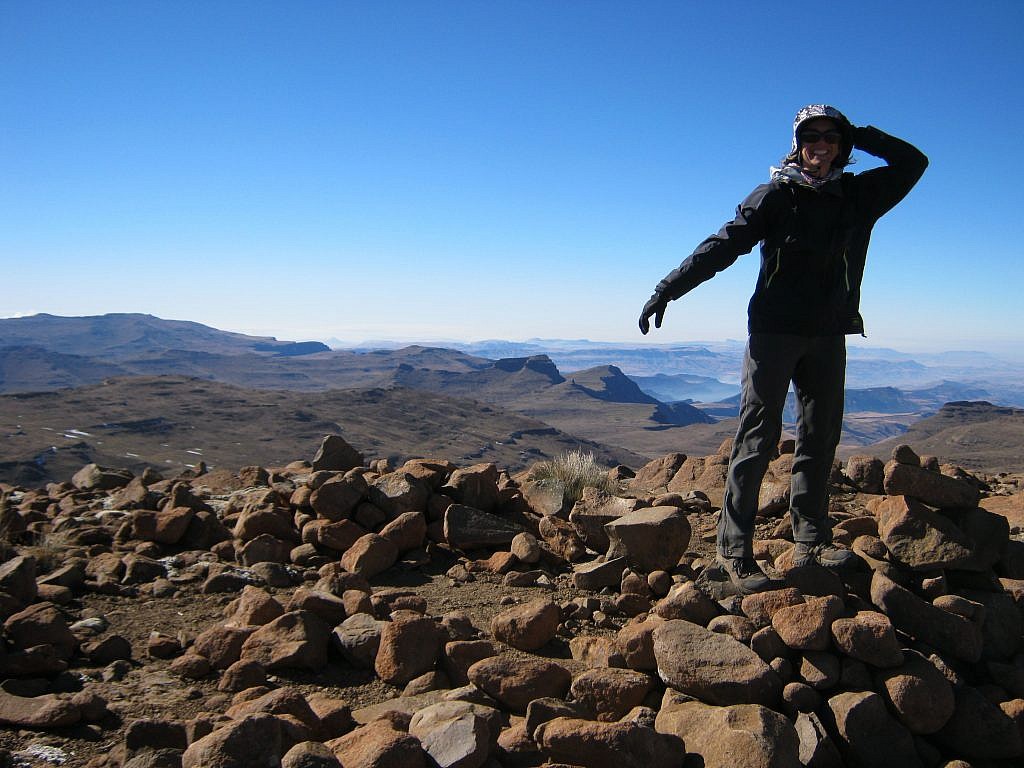
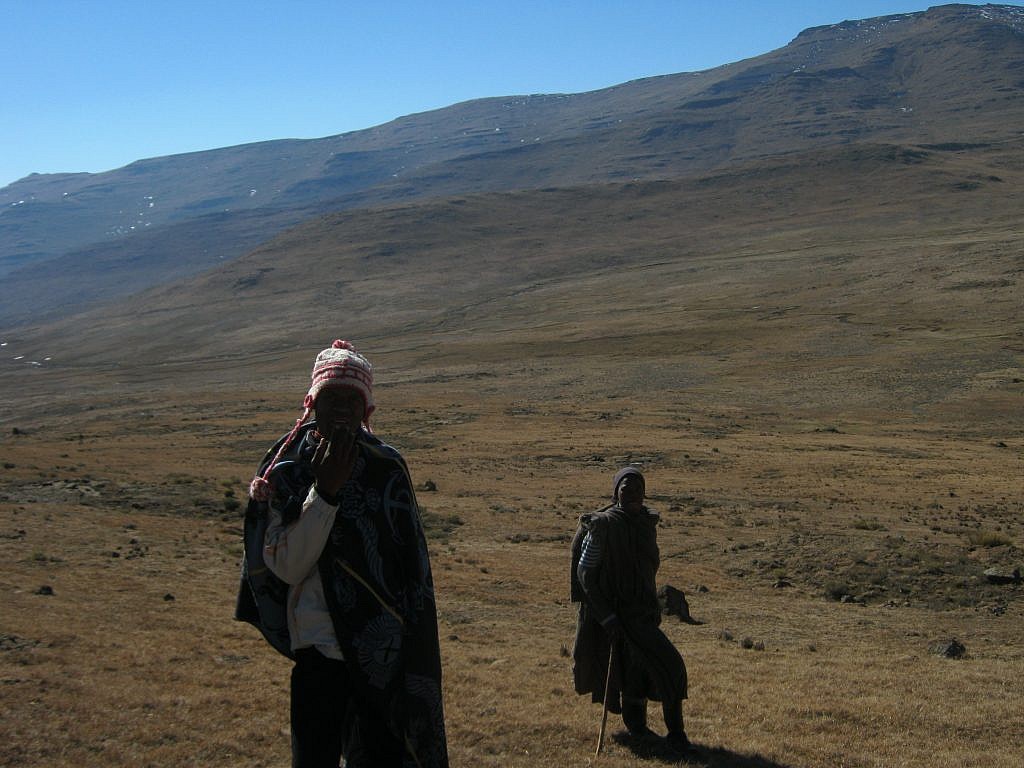
The ascents and descents were more pronounced, and decisions had to be made as to how to contour hills and valleys. Water remained plentiful and we could set up camp just about anywhere, but we still felt nervous about running into natives who were said to rob hikers of everything leaving them stranded in the harsh elements.
One day we saw two people walking across our path towards the pass in the ridge. It all happened quickly and we were unable to avoid them, so came face-to-face with traditionally dressed Lesothans likely making their way to a job far below. Lesotho – pronounced leh-SOO-TOO – is a poor but mineral-rich land-locked country that gained its independence only in 1966.
It was the original lands of the San people, who created the intricate cave paintings seen throughout the region. We were walking now only in Lesotho and would have some explaining to do once we reached Sani Pass and had to re-enter South Africa, but that was still days away.
We camped by a river that night and the next day came upon a valley which needed to be contoured to gain a ridge. In the valley were horses left to graze. Far in the distance I saw a figure who must have been watching over and casually observing our progress.
That night, we camped a good distance away from him in a quiet valley lit by the rising full moon. I was awakened in that still, crisp night by a low thud, repeated unevenly, its sound traveling through the ground. I quietly peaked out of the tent, trying not to wake Ted and there they were, the horses, having moved valleys and come closer to see what we were all about.
Their long, feminine equine faces looked my way with no fear or malice, simply curiosity. It was their hooves that gently awoke me for this magical moment under the silver light of the moon far away from anything.
The next day, we came to a turn off for Thabana Ntlenyana or “beautiful little mountain,” the highest point in Southern Africa. At 11,424 feet, it was only a couple thousand feet of climb on fairly easy rock. But what a thrill, with not a soul around, to know that we were the only two people in all of Southern Africa at this height. It was only a few more days now to Sani Pass where we decided the hiking was finished this time around mainly because the views became less grand and the walking more monotonous.
We chose to stay high before reaching the pass and camped near a frozen waterfall. Glorious by day, it soon became obvious why this creek was all ice when the wind picked up at night and came careening down the mountain like a rollercoaster rushing straight at the tent. My sturdy Sierra Designs four-seasoner buckled under the force pressing right on our faces, then springing back into place like a jack-in-the-box. There was no question of trying to move the tent in the midst of the wind, so we waited it out and marveled at her tensile strength.
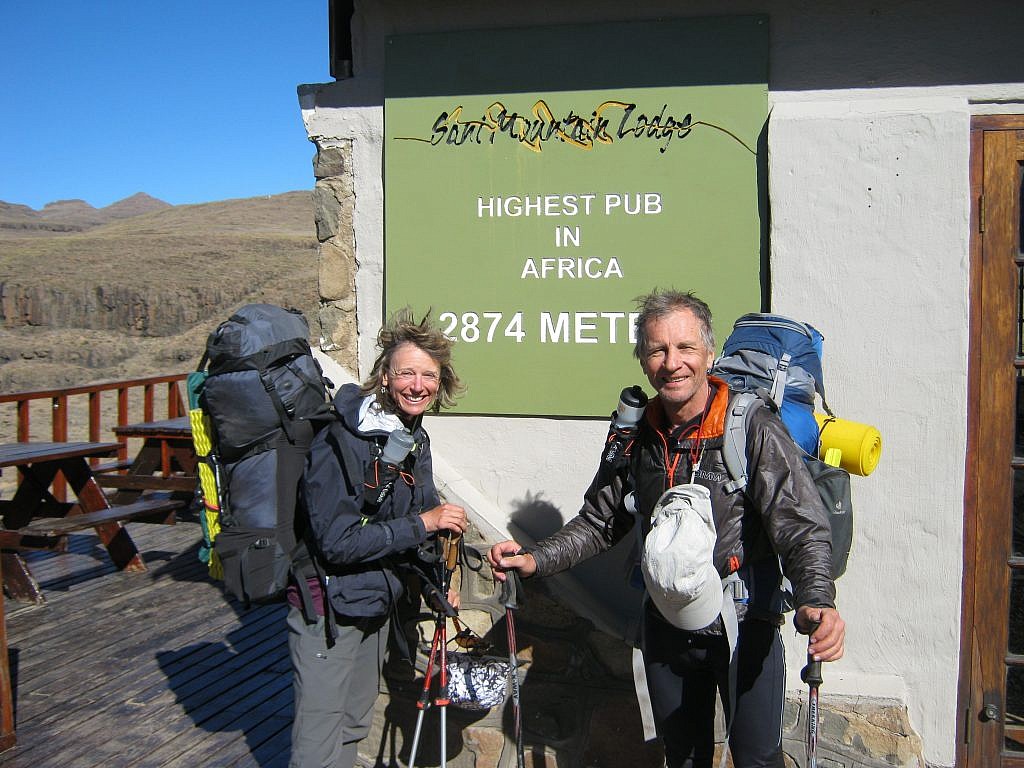
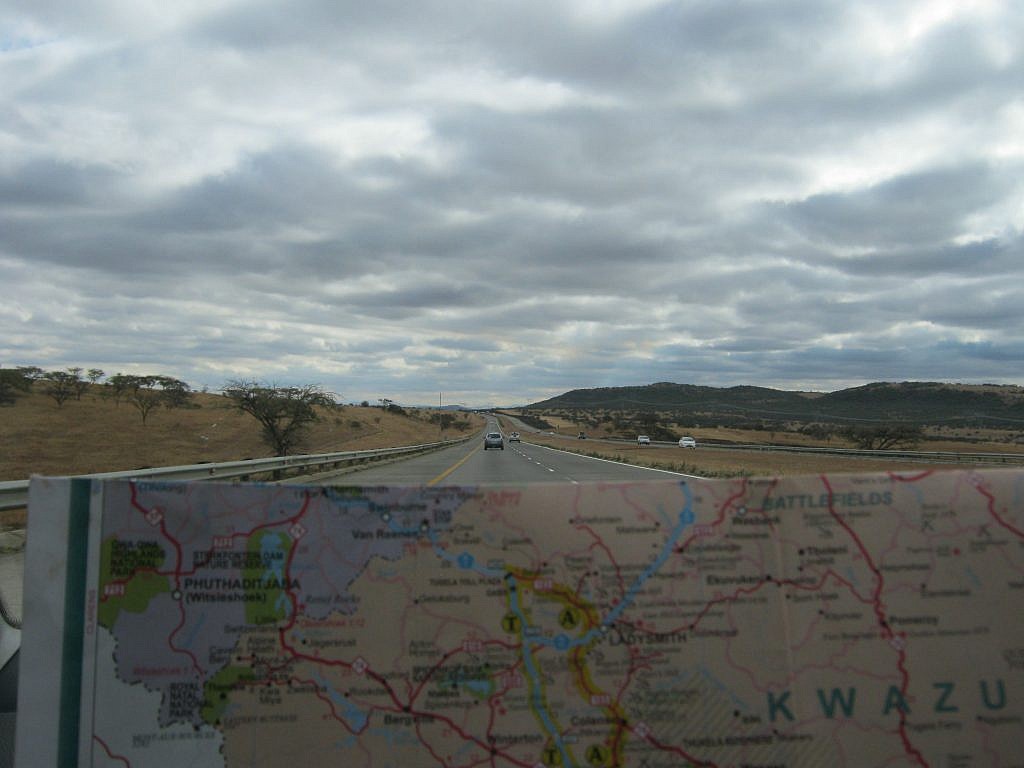
The next day, weary from a loud and dramatic night, we pushed deep into a valley and straight up another giant incline before spying the pass ahead, the only one large enough for vehicles on the entire escarpment. The highest pub in Africa at 9400 feet is a favorite stopping point for tourists and likely a free hitch into town. We scoped out the clientele as we drank a few beers at 10:30 in the morning.
People were awestruck we had walked all the way from the chain ladders – even if we did take a detour to the Cathedral Hotel, which in the end made the hike even more audacious. Finally we found a ride with a couple of Durbin businessman kitted out in a fancy land cruiser and cranking techno-pop all the way down the mountain.
At the border where we re-entered South Africa, we acted dumb, handed over our passports and pushed through before anyone stopped us, then took hot showers and cleaned the kit at the deserted Sani Resort, where it was just us, a father and daughter and a roaring fire at dinner. That night we took a little walk on the ground to stretch the legs and muse on all we’d done and seen. Ted pointed up at the waning moon and asked why it had a hazy ring around it. “Oh Ted, that means the weather is changing! We got the walk in just in time with a perfect weather window.”
And sure enough, once Peter and Gail met us to take us back to the airport, rain moved in and drenched the countryside.


3 Responses